 "Rosalie (a/k/a Rosa, Rose) Myrtle Jones was born in Denison (or a few miles east of it) on December 18, 1873. About four months before she died at age 24, she composed "The
News March," dedicated to the leading newspapers of Texas, The Galveston News and The Dallas News. (The Dallas Morning News, Sunday, May 29, 1898, pg.15)
"Miss Rosa Myrtle Jones of Denison, Texas, already the author of several pieces of piano music, gives promise of taking rank with the foremost composers of the south, if not of America. She was educated at St. Xavier's Academy, graduating with honors. Denison, where at a very early age, she developed quite a taste for the piano. She was given the advantages of the very best institutions in Texas and in 1895 was placed in the Nashville Conservatory of Music, located at 331 N. Summer, under the finest instructor in the south, August Schemmel. Professor Schemmel was announced as the first direction of the Nashville Conservatory of Music within days of its organization in May 1892. The Professor introduced his wife and daughter, Elsa, to a newspaper reporter for The Daily American as his assistants. According to her German birth certificate, Elsa was born August 17, 1875. A month shy of her 17th birthday, she was apparently already sufficiently trained to teach at the Conservatory. The Daily American Nashville Sunday Mornin g, July 17, 1892 IMPORTANT NEWS Interesting to Lovers of Music - A Profitable Visit. As we entered the reception-room at the Vendome building we met a number of gentlemen and ladies discussing the musical art. After a little time of patient waiting we were admitted into the Director's room. We at once informed Prof. August Schemmel, who is the Director of the Nashville Conservatory of Music, that we came to learn something about this institution in order to properly inform the public. The Professor kindly said: Ask your questions and I will cheerfully answer them. We began with: Who are those laides and gentlemen inthe reception room? They are teachers of music. Do they teach in this institution? Oh, No! They receive instructions. Do you instruct teachers here? Certainly. We have now 32 teachers in this institution from this and other States, who receive instructions. Some have taught for years privately and in colleges! Our new methods are welcome information to any progressive teacher of music. We also assist teachers who receive instructions here and to procure good positions 'free gratis." Do you instruct teachers? Oh! no! We have gentlemen and ladies as scholars who could not read a note when they started, and we have children, boys and girls, beginning the study of music. By our new methods they all acqu ire a thorough knowledge of the m usical art pleasantly, easil y and very rapidly. What instruments and what branches of music do you teach in the Conservatory? We take scholars for piano, orgna, violin, viola, violoncello, double bass, flute, clarionet, trombone, cornet and trumpet. We also teach vocal, harmony, fugue, co u nterpoint, composition and orchestration. We have a special department to train pupils for teachers. The Professor then showed us a number of royal tokens of honor bestowed on Prof. Schemmel from various royal authorities of Europe, together with a lot of testimonials, and votes of thanks s ent him from the vario us cities and institutions in the United States. His new methods, some of which he kindly explained, are simply wonderful. The director's wife and daughter, Miss Elsa, who just retu rned from Europe, were introduced to us. The Professor then delighted us by playing serveral of his latest compositions. We begged the ladies to play, which they kindly consented to, and we must confess it is well worth a long, tedious jou rney to witness what we did. Will your wife and Miss Elsa assist you? Certainly. We are a music-loving family. They are thoroughly acquainted with our new methods, and we cannot permit their talent to remain idle. Nashville can justly be proud of such an institution like this. We hope to do our citizens a good service by publishing this news. A very neat catalogue is sent out everywhere upon application free gratis. We wish the Nashville Conservatory of Music all manner of success and most heartily contragulate the institution on such able directorship. The 1895 Nashville City Directory lists Elsa as a teacher. She would have been 19 when it was compiled in late 1894.  She [Rose] was a competitor for the prize offered for the best march for the Tennessee centennial with 300 others, and although not successful in the contest Miss Jones received favorable mention and was placed second on the list. She has since published a number of pieces. One was dedicated to the empress of Germany, who upon receipt of a copy returned a very complimentary letter to the fair Texas composer." (The Dallas (TX) Morning News, Sunday, May 29, 1898, pg. 15) 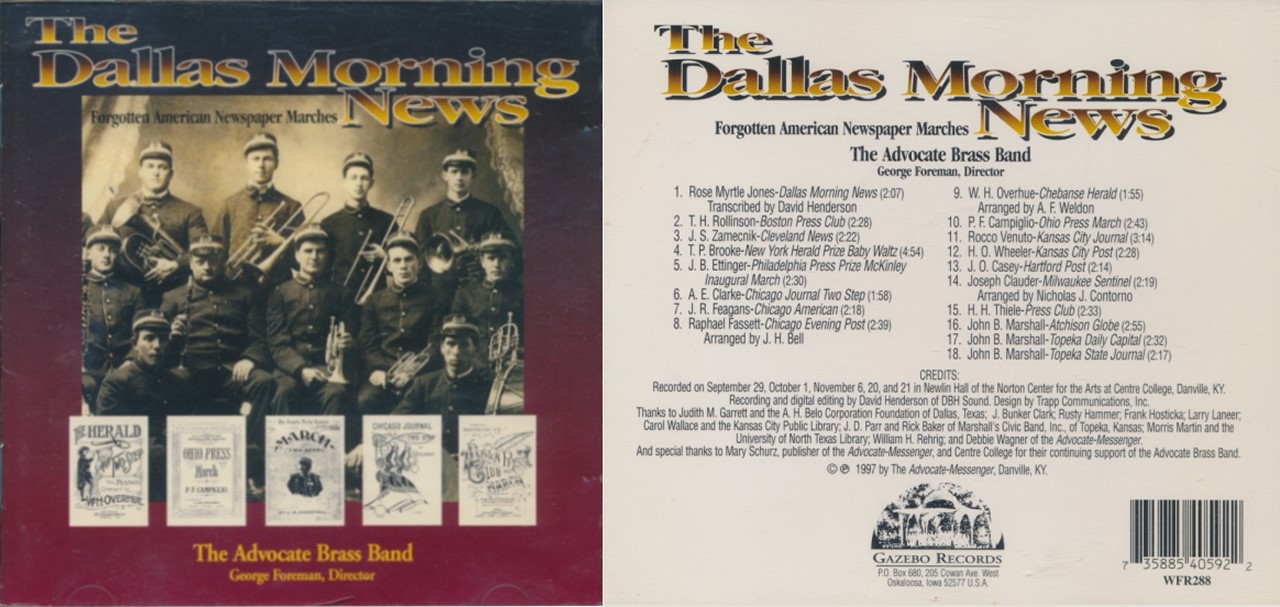 After John Philip Sousa composed "The Washington Post" in 1889, other composers in the 1890s imitated him by creating marches named for other newspapers. The Advocate Brass Band is named for the Advocate-Messenger newspaper in Danville, Kentucky, site of an annual brass band festival. The CD is a collection of forgotten newspaper marches. Rosalie Jones' "News March" is the first track. It is also used (incorrectly) for the title of the CD. She actually titled her march "The News March," for both the Dallas Morning News and the Galveston News. The Dallas paper appears to have capitalized on it more than the one in Galveston. In the fall of 1896 Rose was a bridesmaid in Elsa Schemmel's fall wedding. 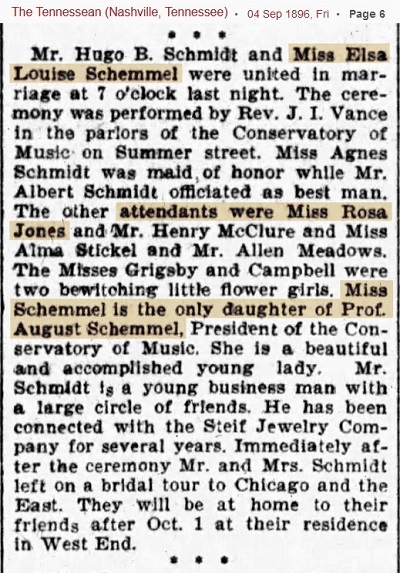 Rose graduated in May 1897 from the Nashville Conservatory of Music at the conclusion her two-year course of study under August Schemmel, head of the conservatory. 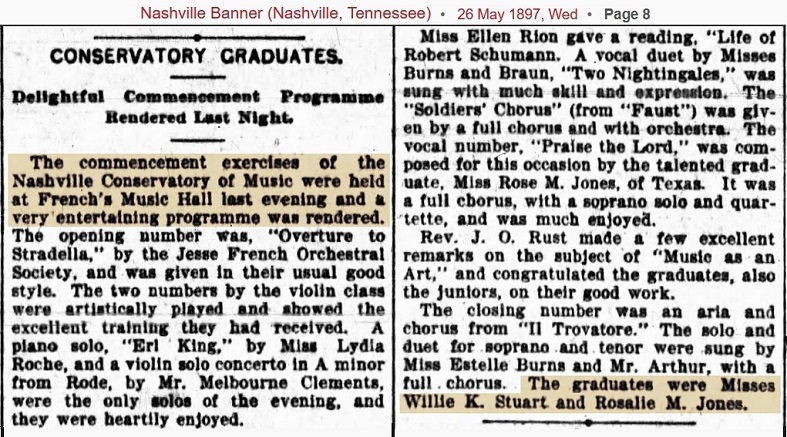 Dr. and Mrs. Schemmel accompanied Rose to Denison in 1897, who lived and taught vocal and instrumental music at 320 North Burnett Avenue. The Gazetteer said in March 1897 that he was considering a permanent relocation to Texas. Rose aand "other puipls of Dr. Schemmel" gave a musical evening at the XXI Club's auditorium on Gandy Street. The Professor wasn't in the habit of hanging around Nashville when school was out for the summer. Apparently Professor Schemmel enjoyed extended stays in the homes of friends in various states. For instance, he spent the summer of 1896 with the Jones family in Denison (reported in The Sunday Gazetteer, March 28, 1897). Whether Mrs. Schemmel and Elsa came with him isn't known. Elsa may have remained in Nashville, since she was going to be married on September 3. Another report in a different paper said he visited a family in another state (Kansas?) in an earlier summer. When he departed for Texas, the fact that he didn't wire his resignation to Nashville from San Antonio until August suggests that the Nashville Conservatory was expecting him to return for the 1897 fall term. The Nashville Conservatory of Music continued to operate under that name for 13 years after the Professor left; The name was changed in 1910 to "The Schubert Conservatory of Music. (Nashville Banner, August 13, 1910, pg. 12) 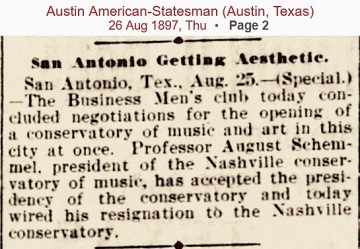 Rose at once proceeded to make use of her talents and musical education. She was the composer of several excellent piano selections, the last of which was the "Galveston-Dallas News March", which attracted wide attention for its merit as a musical composition, and for which Miss Jones received the thanks of the proprietors of the News. They published the selection and received a large number of congratulatory letters from the best musicians of the South. Miss Jones also engaged in teaching, finding great enjoyment from her work. She became one of the foremost representatives of the art of music in this section of Texas, but the work which she voluntarily undertook - from choice, not from necessity - proved too great a strain upon her and undoubtedly hastened her death. [B.B. Paddock, History and Biographical Record of North and West Texas (Chicago: Lewis Publishing Co., 1906), vol. I, pp. 627-628.) 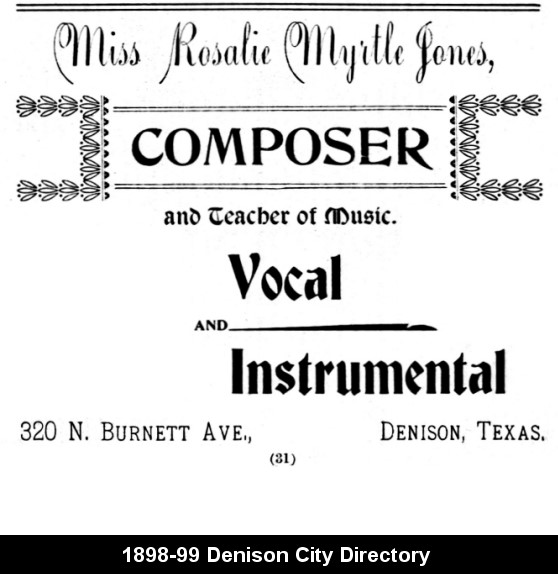 Rose
became suddenly ill after playing the violin in an ensemble at St.
Xavier's graduation ceremonies in June 1898. Despite the best of
doctors' care, she passed away on July 5, 1898.
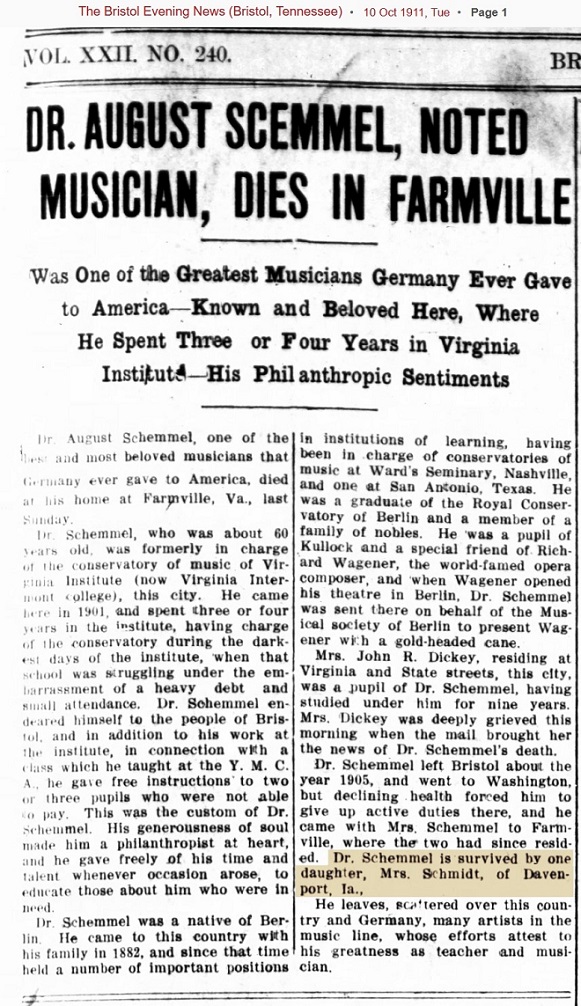 With
the assumption that Dr. and Mrs. Schemmel traveled on to a San Antonio
conservatory before going to Bristol, Virginia in 1901; thence to
Washington D.C. in 1905 and then back to Farmville, Virginia where he
died in October 1911 at the age of 60. The Professor was born in
Berlin, Germany in 1851. One year later he and his family
immigrated to the United States. However, he returned to Germany
to study and graduate from the Royal Conservatory of Berlin. He
was a pupil of Kullock and a special friend of the world-famous opera
composer, Richard Wagener. On July 18, 1874, Dr. Schemmel
married Rosalie Henriette Heilemann in Reinickendorf, Berlin,
Berlin, Deutschland. (Germany, Lutheran Baptism, Marriages and Burials,
1854 - 1938)
 ROSA MYRTLE JONES' FAMILY
For his service in the War for Texas Independence, William T. Lankford (1812 - 1856) received 1,400 acres of land along the Red River between what would later be called Carpenter's Bluff and the Colbert ferry. William, along with his father, Garrett F. Lankford (1795-1864) would own much of the area. The Lankfords' homes, families and lands were often subject to raids by outlaws and hostile Indians crossing the river into Texas from Indian Territory. In 1840 William married the daughter of Dr. William Pasochabi Hunter (1778 - 1847), half-Choctaw, who had moved to Texas from Kentucky on the Trail of Tears. The young couple settled at old Ft. Warren, the county seat of Fannin County. Young Mrs. Lankford passed away 1847. At the end of the year William married Martha Clark Lankford Morris Degraffenreid (1826 - 1903) in Sherman, Grayson County, Texas. William built the first milled lumber house in Grayson County, which sat on the highest point in Grayson County, about 4 and a half miles east of the future site of Denison; the house was a single-story wooden-plank home with a steep, high roof of wooden shingles. The community that grew around the Lankford family was known as "Shiloh." A daughter of William T. Lankford and Martha Clark Lankford, Sarah Berrie Lankford 1849 - 1877), married Dr. James L. Jones, one of the earliest physicians in Grayson County. The young couple made their home near where Sarah had grown up, in the Shiloh community. The couple had three children - Lillian Helen "Lillie" Jones Ringer (1872- 1894), Rosalie Myrtle "Rose" Jones (1873-1898) and James Clark Jones (1876-1880). Sarah and her children preceded their father in death. The family members were buried in Lankford Cemetery, Denison, Grayson County, Texas. B.C. Murray, owner and editor of the Denison Gazetteer, referred to "Shiloh" as "the Dr. Jones neighborhood" and to the Lankford Cemetery as "Jones Cemetery" or "the Jones family burial plot." Dr. Jones married a second time not long after Sarah's death. Sophia Ann O'Dell (1854-1918) was the daughter of Enoch O'Dell, farmer, who in 1858 had settled in the DesVoignes area. Dr. Jones and Sophia raised the children from his first marriage, as well as their own daughter, Frances S. "Fannie" Jones (1885-1945). Dr. Jones acquired much of William Lankford's original land over time and developed the land into a highly productive source of cotton, with the help of hired hands and tenant farmers. Dr. Jones helped to found the Denison Medical Society. He also became a successful businessman opening a drug store in Denison. After the death of Dr. Jones in December 1903, Sophia, widow of Dr. Jones, left the Lankford farm in Grayson County, moving to Oklahoma in 1909 to live with her daughter, son-in-law, and their family. When Sophia died in 1914, she was buried with Dr. Jones in Lankford Cemetery. In print, B.C. Murray mourned the death of Mrs. Dr. Jones, the last of the influential family, "as the end of an era." Bryant, Mavis Anne. Denison, Texas, in 1900: Health and Death, pgs. 91-101. c2017.  Biography Index Susan Hawkins © 2024 If you find any of Grayson County TXGenWeb links inoperable, please send me a message. |